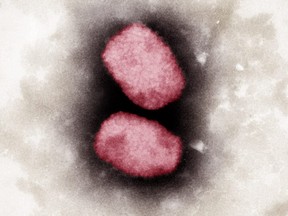Article content
Monkeypox vaccines will now be made available to high-risk groups, B.C.’s Ministry of Health announced Friday.

The World Health Organization has declared a public health emergency because of the global monkeypox outbreak,
Monkeypox vaccines will now be made available to high-risk groups, B.C.’s Ministry of Health announced Friday.
The ministry said that although the number of cases in B.C. remains low, some community transmission has been identified.
As of Wednesday, there were 61 cases of monkeypox in B.C., including three cases in Fraser Health, 54 in Vancouver Coastal Health and four in Island Health. There are no cases in Interior Health and Northern Health.
Health officials will be doing contact tracing for those who have been exposed to the pox.
The vaccine can be used as a preventative measure or given after exposure to prevent illness or severe outcomes.
It would be available to contacts of people who have monkeypox or people who are considered high-risk, said the ministry.
According to the B.C. Centre for Disease Control, the vaccine would be offered primarily to transgender people or men who have sex with other men and meet any of the following criteria:
• Have received a diagnosis of chlamydia, gonorrhea, and/or syphilis in the past two months, or
• Have had two or more sexual partners in the last 21 days, or
• Have attended bath houses, sex clubs, or park play, or plan to
• Have had anonymous sex in the past 21 days, or plan to, or
• Engage in sex work or plan to, either as a worker or a client
Health officials in B.C. say the monkeypox virus does not spread easily from person-to-person. All identified local transmission has involved prolonged skin-to-skin contact, which is suspected to be the primary way the virus is spread
To date, B.C. has received 14,480 doses of vaccine for outbreak control, including post-exposure prophylaxis.
Vaccines are ordered weekly and all doses are distributed to health authorities for administration. As of Wednesday, 7,200 doses were administrated to high-risk people, according to the health ministry.
Last week, the World Health Organization declared a public health emergency of international concern to manage the global monkeypox outbreak.
The Public Health Agency of Canada has urged gay and bisexual men to practise safe sex and limit their number of sexual partners to lower the risk of contracting the disease, which spreads primarily among men who have sex with men.
Monkeypox can occur in two stages, with flu-like symptoms appearing first, followed by a rash, usually with sores or blisters, though many people only get the rash.
The Centers for Disease Control and Prevention in the United States says 21,148 cases of monkeypox have been reported globally, with most of the cases identified in 71 countries, including Canada, that have not historically reported the illness.
— With files from The Canadian Press

MILWAUKEE (AP) — Whooping cough is at its highest level in a decade for this time of year, U.S. health officials reported Thursday.
There have been 18,506 cases of whooping cough reported so far, the Centers for Disease Control and Prevention said. That’s the most at this point in the year since 2014, when cases topped 21,800.
The increase is not unexpected — whooping cough peaks every three to five years, health experts said. And the numbers indicate a return to levels before the coronavirus pandemic, when whooping cough and other contagious illnesses plummeted.
Still, the tally has some state health officials concerned, including those in Wisconsin, where there have been about 1,000 cases so far this year, compared to a total of 51 last year.
Nationwide, CDC has reported that kindergarten vaccination rates dipped last year and vaccine exemptions are at an all-time high. Thursday, it released state figures, showing that about 86% of kindergartners in Wisconsin got the whooping cough vaccine, compared to more than 92% nationally.
Whooping cough, also called pertussis, usually starts out like a cold, with a runny nose and other common symptoms, before turning into a prolonged cough. It is treated with antibiotics. Whooping cough used to be very common until a vaccine was introduced in the 1950s, which is now part of routine childhood vaccinations. It is in a shot along with tetanus and diphtheria vaccines. The combo shot is recommended for adults every 10 years.
“They used to call it the 100-day cough because it literally lasts for 100 days,” said Joyce Knestrick, a family nurse practitioner in Wheeling, West Virginia.
Whooping cough is usually seen mostly in infants and young children, who can develop serious complications. That’s why the vaccine is recommended during pregnancy, to pass along protection to the newborn, and for those who spend a lot of time with infants.
But public health workers say outbreaks this year are hitting older kids and teens. In Pennsylvania, most outbreaks have been in middle school, high school and college settings, an official said. Nearly all the cases in Douglas County, Nebraska, are schoolkids and teens, said Justin Frederick, deputy director of the health department.
That includes his own teenage daughter.
“It’s a horrible disease. She still wakes up — after being treated with her antibiotics — in a panic because she’s coughing so much she can’t breathe,” he said.
It’s important to get tested and treated with antibiotics early, said Dr. Kris Bryant, who specializes in pediatric infectious diseases at Norton Children’s in Louisville, Kentucky. People exposed to the bacteria can also take antibiotics to stop the spread.
“Pertussis is worth preventing,” Bryant said. “The good news is that we have safe and effective vaccines.”
___
AP data journalist Kasturi Pananjady contributed to this report.
___
The Associated Press Health and Science Department receives support from the Robert Wood Johnson Foundation. The AP is solely responsible for all content.
The Canadian Press. All rights reserved.

How a sperm and egg fuse together has long been a mystery.
New research by scientists in Austria provides tantalizing clues, showing fertilization works like a lock and key across the animal kingdom, from fish to people.
“We discovered this mechanism that’s really fundamental across all vertebrates as far as we can tell,” said co-author Andrea Pauli at the Research Institute of Molecular Pathology in Vienna.
The team found that three proteins on the sperm join to form a sort of key that unlocks the egg, allowing the sperm to attach. Their findings, drawn from studies in zebrafish, mice, and human cells, show how this process has persisted over millions of years of evolution. Results were published Thursday in the journal Cell.
Scientists had previously known about two proteins, one on the surface of the sperm and another on the egg’s membrane. Working with international collaborators, Pauli’s lab used Google DeepMind’s artificial intelligence tool AlphaFold — whose developers were awarded a Nobel Prize earlier this month — to help them identify a new protein that allows the first molecular connection between sperm and egg. They also demonstrated how it functions in living things.
It wasn’t previously known how the proteins “worked together as a team in order to allow sperm and egg to recognize each other,” Pauli said.
Scientists still don’t know how the sperm actually gets inside the egg after it attaches and hope to delve into that next.
Eventually, Pauli said, such work could help other scientists understand infertility better or develop new birth control methods.
The work provides targets for the development of male contraceptives in particular, said David Greenstein, a genetics and cell biology expert at the University of Minnesota who was not involved in the study.
The latest study “also underscores the importance of this year’s Nobel Prize in chemistry,” he said in an email.
___
The Associated Press Health and Science Department receives support from the Howard Hughes Medical Institute’s Science and Educational Media Group. The AP is solely responsible for all content.
The Canadian Press. All rights reserved.

Patients who are older, don’t speak English, and don’t have a high school education are more likely to experience harm during a hospital stay in Canada, according to new research.
The Canadian Institute for Health Information measured preventableharmful events from 2023 to 2024, such as bed sores and medication errors,experienced by patients who received acute care in hospital.
The research published Thursday shows patients who don’t speak English or French are 30 per cent more likely to experience harm. Patients without a high school education are 20 per cent more likely to endure harm compared to those with higher education levels.
The report also found that patients 85 and older are five times more likely to experience harm during a hospital stay compared to those under 20.
“The goal of this report is to get folks thinking about equity as being a key dimension of the patient safety effort within a hospital,” says Dana Riley, an author of the report and a program lead on CIHI’s population health team.
When a health-care provider and a patient don’t speak the same language, that can result in the administration of a wrong test or procedure, research shows. Similarly, Riley says a lower level of education is associated with a lower level of health literacy, which can result in increased vulnerability to communication errors.
“It’s fairly costly to the patient and it’s costly to the system,” says Riley, noting the average hospital stay for a patient who experiences harm is four times more expensive than the cost of a hospital stay without a harmful event – $42,558 compared to $9,072.
“I think there are a variety of different reasons why we might start to think about patient safety, think about equity, as key interconnected dimensions of health-care quality,” says Riley.
The analysis doesn’t include data on racialized patients because Riley says pan-Canadian data was not available for their research. Data from Quebec and some mental health patients was also excluded due to differences in data collection.
Efforts to reduce patient injuries at one Ontario hospital network appears to have resulted in less harm. Patient falls at Mackenzie Health causing injury are down 40 per cent, pressure injuries have decreased 51 per cent, and central line-associated bloodstream infections, such as IV therapy, have been reduced 34 per cent.
The hospital created a “zero harm” plan in 2019 to reduce errors after a hospital survey revealed low safety scores. They integrated principles used in aviation and nuclear industries, which prioritize safety in complex high-risk environments.
“The premise is first driven by a cultural shift where people feel comfortable actually calling out these events,” says Mackenzie Health President and Chief Executive Officer Altaf Stationwala.
They introduced harm reduction training and daily meetings to discuss risks in the hospital. Mackenzie partnered with virtual interpreters that speak 240 languages and understand medical jargon. Geriatric care nurses serve the nearly 70 per cent of patients over the age of 75, and staff are encouraged to communicate as frequently as possible, and in plain language, says Stationwala.
“What we do in health care is we take control away from patients and families, and what we know is we need to empower patients and families and that ultimately results in better health care.”
This report by The Canadian Press was first published Oct. 17, 2024.
Canadian Press health coverage receives support through a partnership with the Canadian Medical Association. CP is solely responsible for this content.
The Canadian Press. All rights reserved.


Netflix’s subscriber growth slows as gains from password-sharing crackdown subside


Bad weather forecast for B.C. election day as record numbers vote in advance polls
Champlain CBP Officers Recover Stolen Vehicle


Promise tracker: What the Saskatchewan Party and NDP pledge to do if they win Oct. 28


Tobacco giants would pay out $32.5B to provinces, smokers in ‘historic’ proposed deal


Here are the key numbers in the deal proposed by three tobacco giants


Toronto FC promises change at the club after missing out on the playoffs yet again
CB Series – Front Office Pro Series Trade Floor Business Analysis